Here’s A Simple Brötchen Recipe For Tasty German Bread Rolls!
Looking for a simple to make breakfast roll recipe? German bread rolls are the answer!
Made from just a few ingredients common in the pantry, this Brötchen recipe delivers German rolls that are crusty on the outside and soft on the inside.
These simple buns go really well with a breakfast or brunch – but can be enjoyed at lunch or heated up as a warm dinner roll, too!
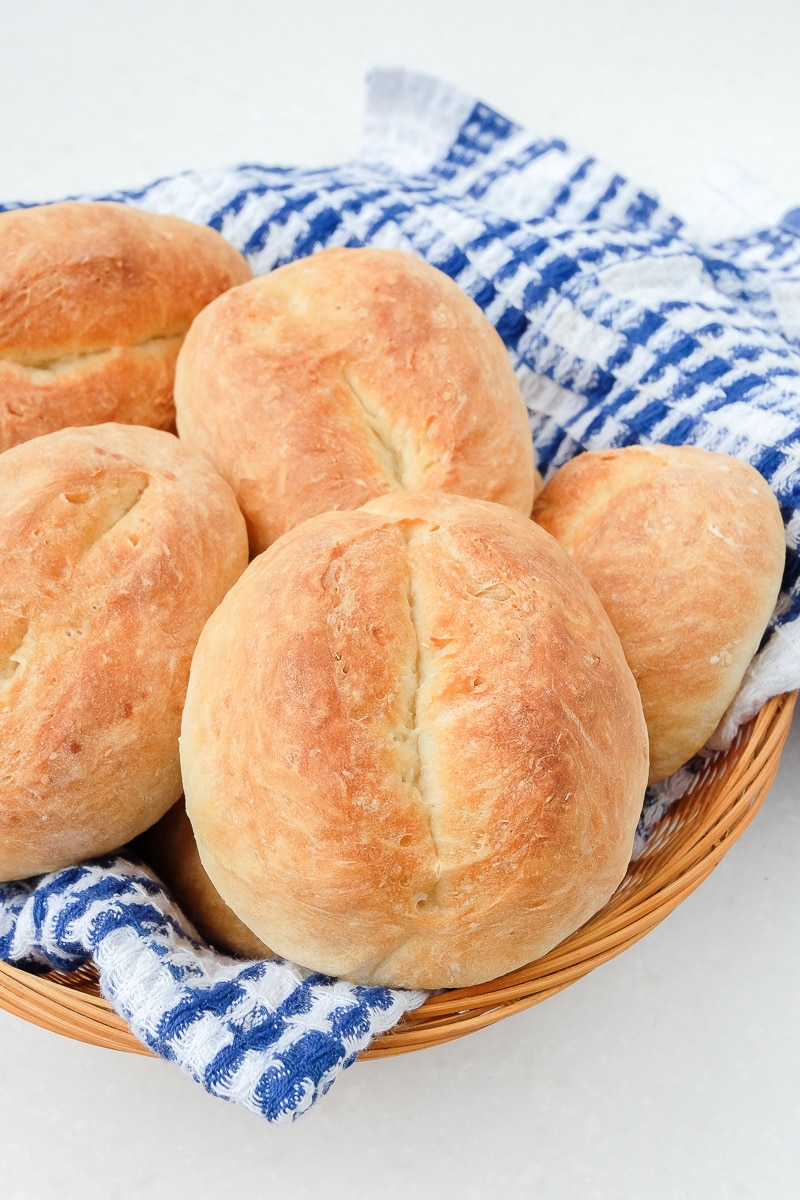
Meaning of Brötchen
For those wondering, the literal meaning of Brötchen in English is essentially “small bread”.
“Brot” means bread in German and the ending “-chen” is sometimes added when you want to emphasize that you’re talking about something smaller.
Brötchen – in English sometimes written as Brotchen since the German letter “ö” is not being used – is basically just the German word for bun or bread roll.
Brötchen in Germany
Brötchen are popular all over Germany and there are many, many different types of German Brötchen out there. Ours is just a very basic, classic version.
If you’ve visited Germany before, you’ve most likely noticed that Germans love their bread in all shapes and sizes.
So it’s no surprise that there are many different bread roll options out there. Have a look inside a few different German bakeries and you’ll understand what we mean!
Lisa grew up eating them, obviously. They were always a popular addition to weekend breakfasts with the family. One family member would usually go to the bakery early in the morning to grab some freshly made buns for the family.
Eric really never appreciated how good a warm Brötchen in the morning can be until he met Lisa. It’s great to have a whole spread of meats, cheeses, and sweet or savory spreads to put on them!
Looking for more recipes? Try our Strammer Max, Farmer’s Omelette, easy Schinkennudeln, or a classic German salad!
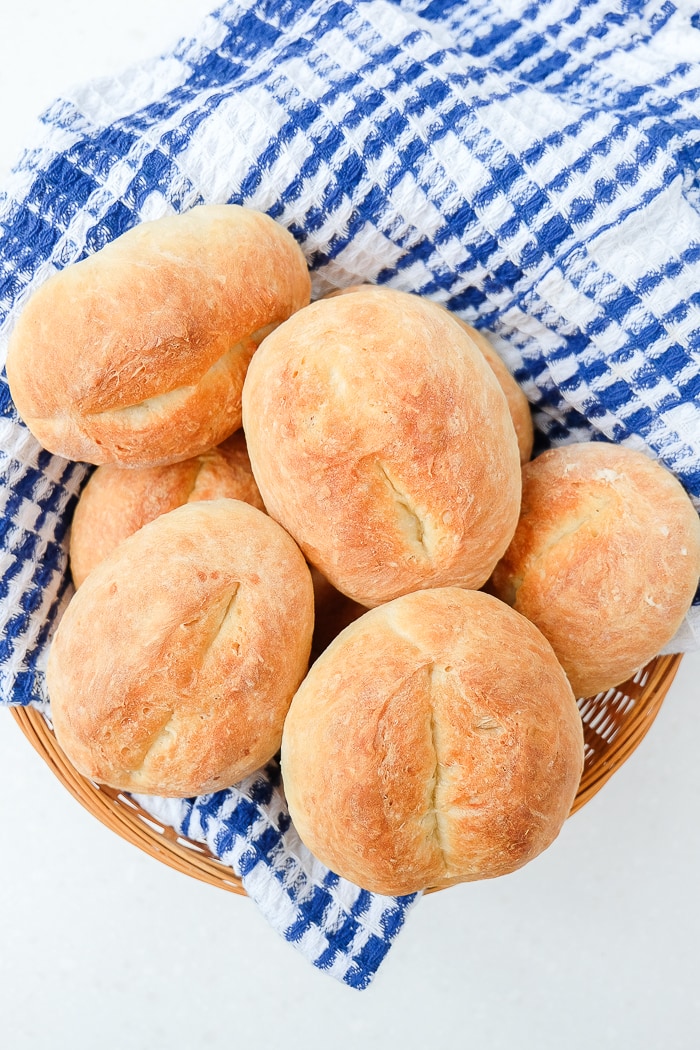
How to Make Authentic German Brötchen – Step by Step
If you plan to take on this simple German bread rolls recipe, you can find the recipe card with exact measurements at the bottom of this post!
For those bakers who want to see what the recipe steps look like, you can follow the Brötchen process photos right now!
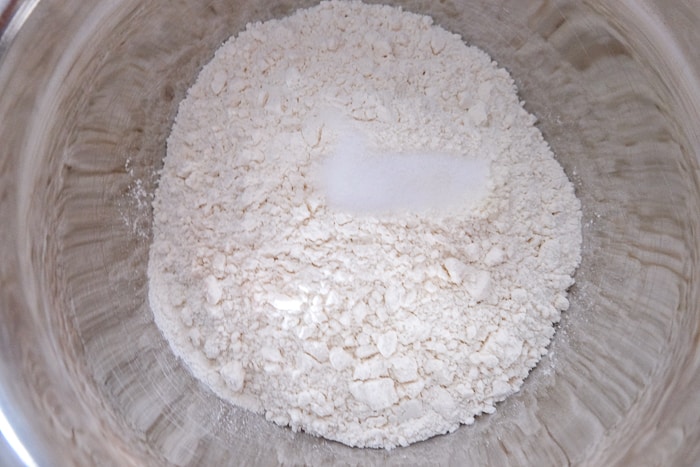
Start by adding flour to a large mixing bowl. Add in the salt and give everything a stir.
Yeast and salt don’t like each other so make sure that the salt is mixed in with the flour before adding any yeast.
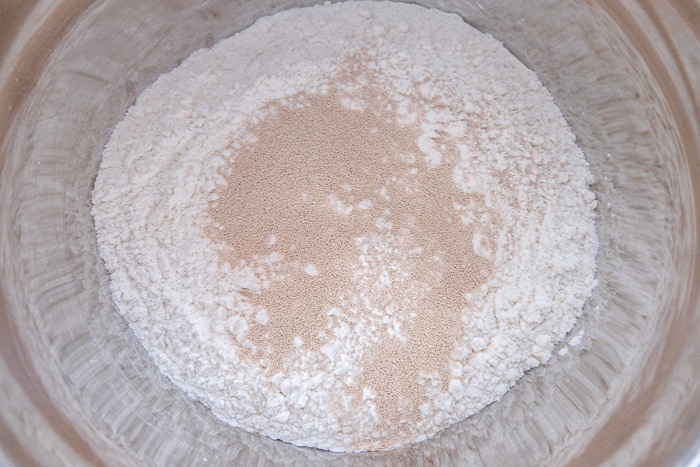
Now sprinkle the sugar on top and finally add your instant yeast.
Make sure that the yeast doesn’t have to be dissolved in water first – if it does, check the notes in the recipe card below for recommendations on how to proceed!
Finally, slowly add the water while using the spiral dough hooks of your electric mixer to knead the dough. Of course you can also use your hands – it just takes a bit longer.
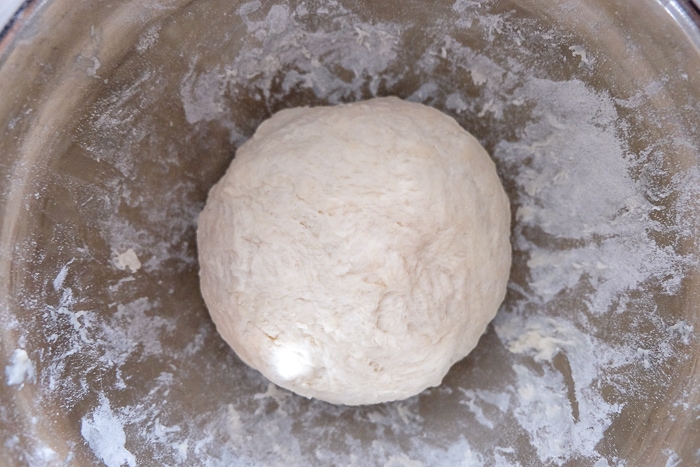
Keep kneading until the dough forms a ball that doesn’t stick to the side of the bowl anymore.
If the dough is to crumbly after a few minutes of kneading, you can add a little bit more water.
On the other hand, if it is too wet and sticky, you can add a little bit more flour.
Cover the bowl with the dough and place it in a warm spot in your home without a draft for 60 minutes.
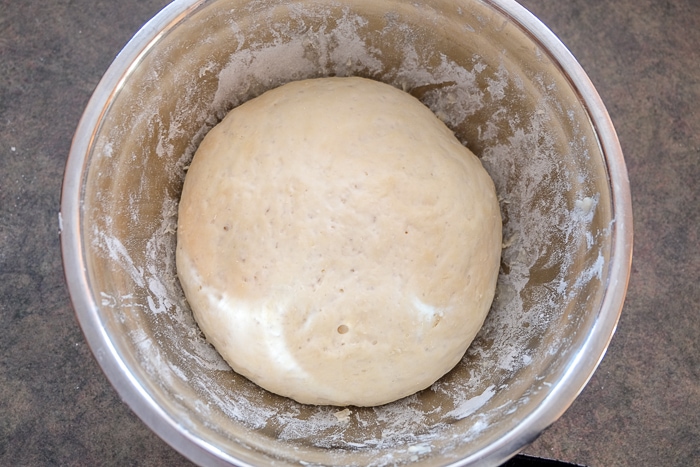
After the hour is up and the dough has increased in size, sprinkle some flour onto your countertop.
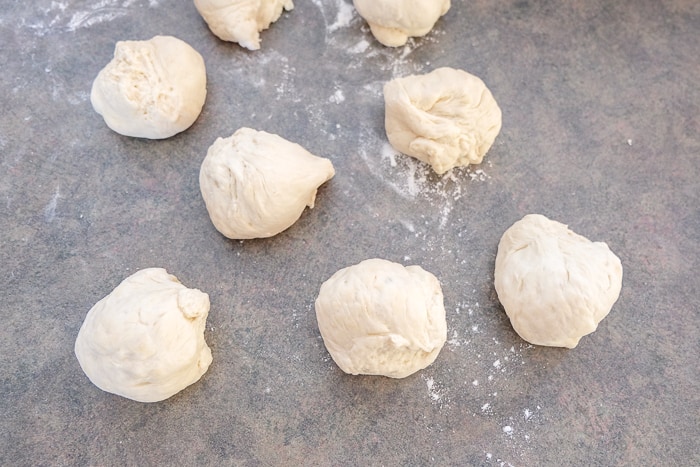
Knead the dough briefly with your hands, then cut or rip it into eight parts of equal size and form it into bread rolls.
The rolls will look nicer if you try to keep the “seams” on the bottom.
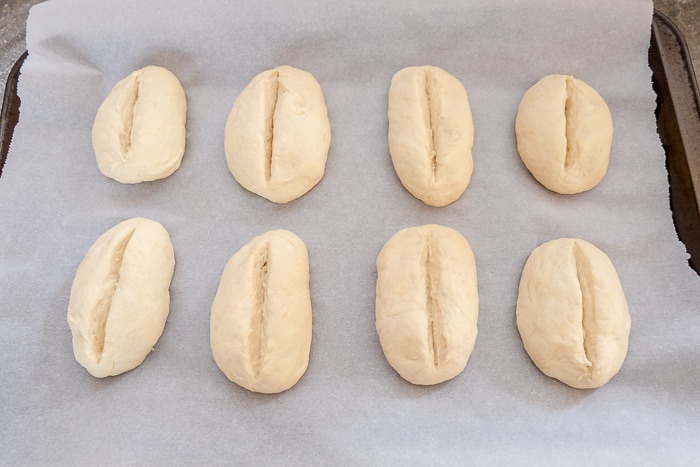
Place the rolls on a baking sheet lined with parchment paper. Cut the bread rolls lengthwise with a sharp knife about 1/3 deep.
If you don’t cut them enough they might turn out more like “bread balls” – but they will still be delicious.
Let the rolls sit on the parchment paper for another 15 minutes. While you wait, preheat your oven to 420 degrees Fahrenheit.
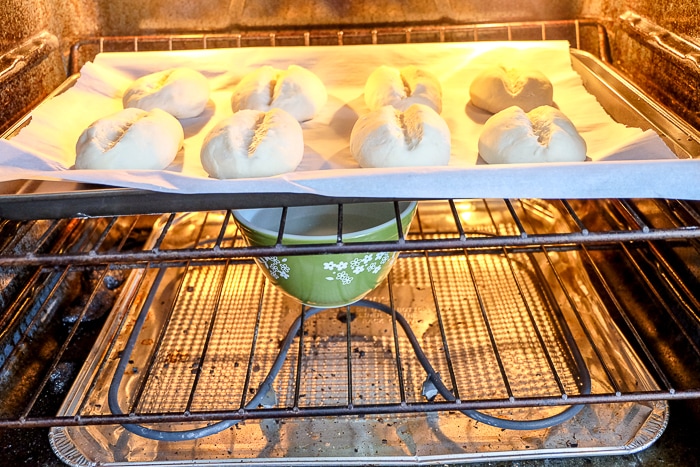
Place a heat-resistant bowl with water in the bottom rack of your oven. This will help the buns to rise better and can make the crust more crispy.
Bake the German buns on the middle rack of your oven for around 20 minutes until they are golden brown.
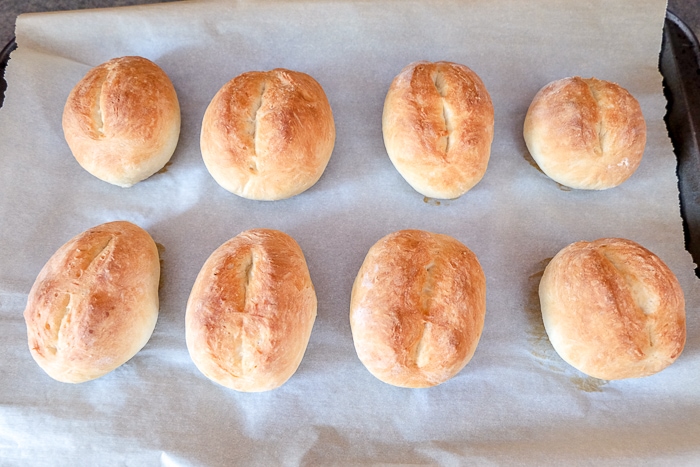
Remove them from the oven and let them sit for a few minutes. You can enjoy the Brötchen warm or cold.
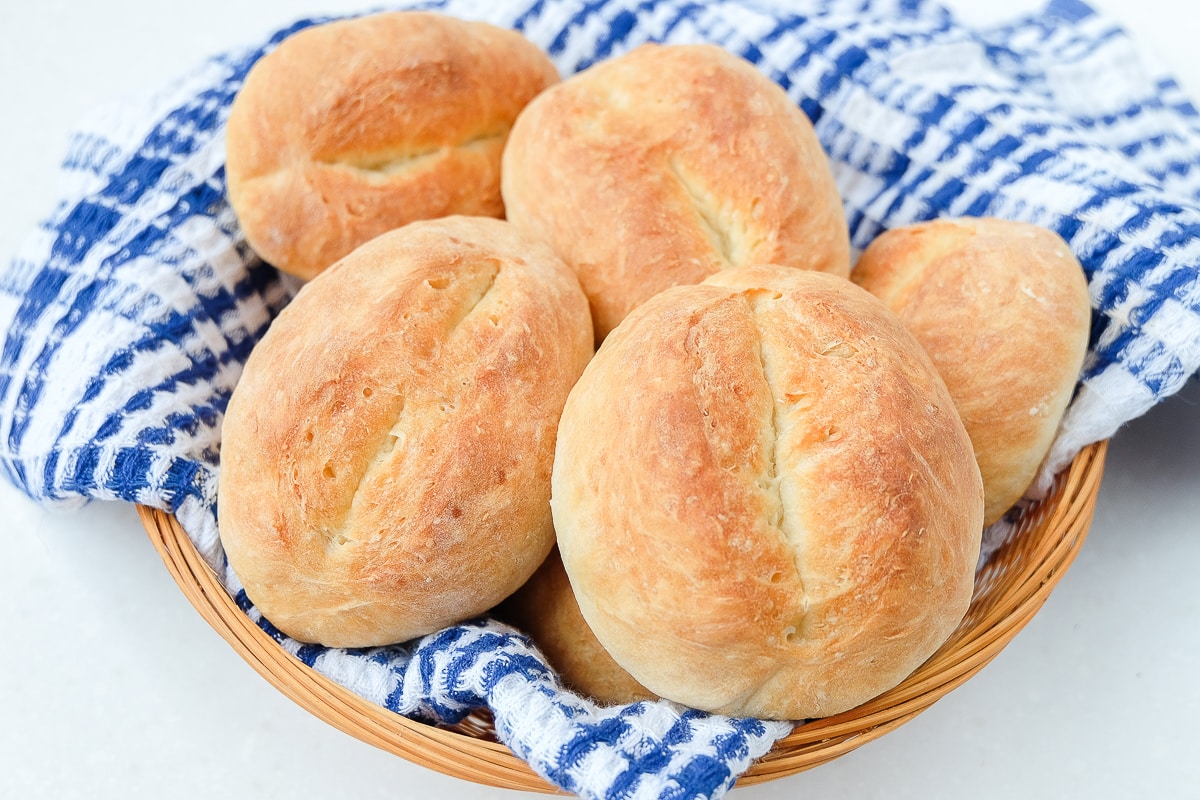
Storage Tips
Brötchen taste best fresh in our opinion. However, you can store any leftover buns in a plastic bag or container.
When you want to eat them, cut them open and place them for a few minutes in the oven or in your toaster. This will make them slightly crispy again.
If you have old buns that you don’t want to eat anymore, leave them out on the counter so they can really harden.
Then you can use them to make German bread dumplings – also known as Semmelknoedel. Or cut them up and make croutons to add to a hearty potato soup!
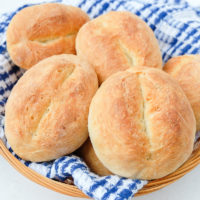
Brötchen (German Bread Rolls)
Ingredients
- 3 cups all-purpose flour
- 1 teaspoon salt
- 1/4 teaspoon sugar
- 2 teaspoons instant dry yeast
- 1 1/4 cups water, lukewarm
Instructions
- Add flour to a large mixing bowl, then add the salt and give everything a good stir. Sprinkle the sugar on top and finally add the instant yeast.
- Slowly add the water while using the spiral dough hooks of your electric mixer or your hands to knead the dough. Keep kneading until the dough forms a ball that doesn’t stick to the side of the bowl anymore. If it’s too crumbly after a few minutes, add a tiny bit more water. If it is too wet, add a little bit more flour.
- Cover the bowl with a dishtowel or lid and place it in a warm spot without a draft for at least 60 minutes to allow the dough to rise.
- After the dough has increased in size, sprinkle some flour onto your countertop. Place the dough on it and briefly knead it with your hands.
- Cut or rip the dough into eight equal parts and form it into bread rolls. Make sure that the "seams" are at the bottom. Place these rolls on a baking sheet with parchment paper.
- Cut the bread rolls lengthwise with a sharp knife about halfway deep. Then let them sit for another 15 minutes.
- In the meantime, preheat your oven to 420 degrees Fahrenheit. Place a heat resistant bowl or small pot with water into the bottom of your oven. Bake the Brötchen on the middle rack for approx. 15-20 minutes until golden brown.
- Remove the bread rolls from the oven and let them cool slightly. They can be eaten warm or cold.
Notes
- We use instant dry yeast for this recipe – aka the type of yeast that doesn’t have to be dissolved in water or milk first. Make sure to check the directions on the package of your yeast first. If it needs to be dissolved first, add it to 1/4 cup water and 1/4 teaspoon sugar and let it sit for around 10 minutes. Then add this to the flour in the mixing bowl – and make sure to subtract the amount of water and sugar already used from the ingredient list above!
- Also, make sure that your yeast hasn’t expired yet and that the salt and yeast don’t get into direct contact with each other. Otherwise, your dough might not rise at all.
- This is a recipe for a very simple German bun. There are many different kinds of German buns you can make or buy in Germany… and we’ll add more recipes over time!
Nutrition
This nutritional information has been estimated by an online nutrition calculator. It should only be seen as a rough calculation and not a replacement for professional dietary advice.
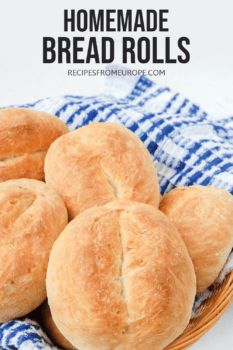
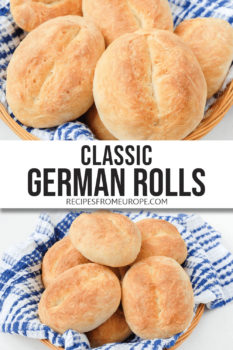

I agree with “Anonymous” (27 March 2024) that the ingredients should be by weight – preferably in metric as most of the world uses metric. A gram is a gram all over the world, but teaspoons and cups can vary.
Thanks for your comment! I agree with you that in general metric measurements are better for baking since they are more accurate. However, since living in the US and Canada I have learned that many people don’t even own a kitchen scale and would never make a recipe with metric measurements since they are unfamiliar with it, so I have to consider that as well (the majority of our readers are from the US and Canada). I’ll try to find a balance in the future and include metric measurements for recipes where accuracy is very important (such as this recipe) /Lisa
While this is a great recipe, Id like a little more clarity. Weights would be a much prefered way of conveying the amount of each ingredient. Id also like to know how much water should be placed under the bread while it is cooking and when exactly to put it in. Should it be boiling when it enters the oven, for example. I would also like to know about the shape, you say the cut it lengthwise but to roll it into balls in the step by step instructions (I should have looked at the longer instructions above with pictures but who has the time, amiright). I have also never seen any baking instructions that say to cut 15 minutes before placing it into the oven; only ever right before.
I am only offering this as some constructive criticism. The vague instructions can lead to a lot of inconsistency. Mine turned out okay, but a little smaller/denser and oddly shaped than I was hoping for. The exterior was nice and crusty, like I remember from germany
I do love how easy this recipe is, in terms of on-hand ingredients and how the short the timeframe is. I also like how you clarified the use of instant dry yeast vs other types. I would have made that mistake if not for the note.
Thanks for your detailed comment, I appreciate it! We’re always looking to improve our recipes and make them as helpful as possible. This one is definitely in need of an update and hopefully I’ll get to it in the next week or two.
Made these today to go with some brats, and I was taken back to the first time I had a good German brat and the crusty bread I’d been missing! Thank you for this simple, yet perfect recipe. ❤️
Another thing to do when they get hard – croutons are nice, but I’d grind them into breadcrumbs and make schnitzel !!
That’s a great tip, thanks for sharing Karin!
Tried them, but couldn’t agree with most of the followers… – far away from the typical taste in Germany – there are better and more orginal recipes on the market
Thanks for giving them a try and leaving your feedback, Marta! I’m sorry to hear that you didn’t enjoy them. I know that personal tastes are different, same as there are many variations of Brötchen (some denser, some fluffier). I’m still working on perfecting the recipe and hopefully will be able to give people tips for adapting it to their preference soon. /Lisa
This is a great simple recipe! Since I discovered it, I’ve been making these every week!
I did make a couple small changes. I add a tablespoon of vegetable oil to the mix, and I increased the sugar by 2x. Also, I add the water, yeast and sugar to the bowl and mix, then add the salt and let it proof for 5 mins before adding the flour (I use a stand mixer). I use bread flour instead of all purpose flour as I find that it rises a bit higher. If you use a bread booster, or add vitamin C to the mix, your buns will almost double in size from regular.
Hi Ryan, thanks for sharing your tips! I’m still experimenting with perfecting this recipe so I really appreciate your comment. /Lisa
I bake lots of typical German breads. This Brotchen Recept is fine. However, I would recommend slicing the rolls only just before placing them into the oven. That would eliminate them to flatten if the dow is soft. If using a machine, best to place the water in the machine first and add the yeast. Allow the yeast to dissolve and then add sugar and flour. Mix it on slow a couple minutes and only then add the salt. All these details will enhance your chance of total success.
Thanks for your tips, Gerhard – this recipe is far from perfect (yet) so I really appreciate your comment! /Lisa
what flour is best, most authenic, for these broetchen? spelt, more like cake flour or regular American unbleached flour?
thank you!!
In Germany, there are different types of Brötchen made with different types of flour (sometimes it can actually be a bit overwhelming seeing all the Brötchen choice in German bakeries). I would typically use wheat flour type 550 to make these classic Brötchen in Germany – based on the protein content, this is very similar to North American all-purpose flour. But you could definitely try using spelt flour to make “Dinkelbrötchen”. I’m still trying to find the “perfect” flour myself to make my homemade Brötchen as good as possible, but I hope this helps a bit! /Lisa
My mom and her friends were always complaining about how American and German bread tasete so different. After asking the people at King Arthur Flour about it I received a 3 page treatise on flour. German type 405 is light (pastry) flour, 550 is general purpose flour and the numbers go up from there to 1700 which is dark pumpernickel. Most online receipies do not give a type number to use. In a recent telephone conversation to Germany I had mom ask her girlfriend about bread flour. The answer was “flour is flour”. So the great flour mystery continues …
Thank you. I spent three years in west Germany in the early 1980’s with the US Army. bBrotchen and shopping for it each day is one of the things I miss. It was much more personal shopping experience there in Bavaria.
I have not made this yet but I would very much like to. I’ve been really craving some hard, German bread but it’s basically impossible to find in the US.
Anyway, my question is: is this bread very hard/toasted on the outside?
I wouldn’t say that the bread rolls are very hard on the outside, but they are crusty. I completely understand when you say that you are missing hard German bread (sometimes I feel the same). Hopefully at some point I’ll have a good recipe for German bread that I can share – but at the moment I’m still experimenting. /Lisa
I understand your desire for hard German bread. We moved to Canada/ Toronto area almost 60 years ago and have always been buying German Brot and Broetchen. Our favorite bakery is Dimpflmeier in Toronto. They ship their goods to many places in the States. We found it in Florida! They have a factory outlet about 50 km from us and we drive there three or five times a year to stock up on our favorite breads. We wouldn’t want to be without it.
Easy recipe to make and the Brötchen are absolutely delicious. They didn’t get the light golden brown I was hoping for, but the taste is wonderful
Did you forget to put the sugar in? That’s what helps them brown while baking
My Brotchen took a little longer in the oven to turn golden brown.
They tasted good but we thought Brotchen should be lighter. These
seem rather heavy. Crust was nice however. Used King Arthur flour.
Thanks for the feedback Jim! Some ovens cook hotter than others unfortunately so the cooking is not always 100% accurate. We’ve since moved house so I’ll test this recipe with our new oven again to see if my times were off. In Germany there are different types of Brötchen as well – some are very light, fluffy, and airy while others are denser. When updating this post I’ll be more specific about that. /Lisa
Great easy recipe, works perfectly every time. Love it
Delicious! Though mine came out a little doughy inside while the outside was brown and well baked. Almost as good as I remember them being in Germany. Wondering if my oven is running a bit hot…
I lived in Germany for about 20 years while in the service. German food of almost any kind is a plus for Me. But I have missed the Brochen the most, with Bratwurst,or cold cuts, and schnizel sandwiches !! This simple recieot was perfect !!!!!! These taste wonderful. I was always looking for the type of flour used in Germany not knowing if there was a great difference ?? But These hit the spot, Thank You !!!
I have made these a couple times now, they taate very good
Excited to try these with Würsten!
Looks good and simple .
I will let you know what the result was. Thanks.
Jaap , the Netherlands.
I love German Bread Rolls and recipes. Thank you.